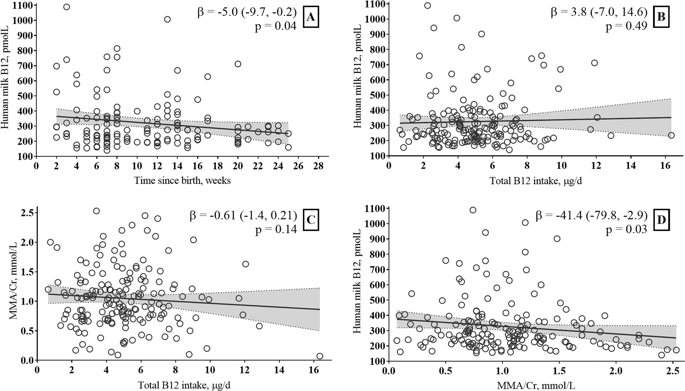当前位置:
X-MOL 学术
›
Eur. J. Clin. Nutr.
›
论文详情
Our official English website, www.x-mol.net, welcomes your feedback! (Note: you will need to create a separate account there.)
Vitamin B12 concentrations in milk from Norwegian women during the six first months of lactation.
European Journal of Clinical Nutrition ( IF 4.7 ) Pub Date : 2020-01-30 , DOI: 10.1038/s41430-020-0567-x Sigrun Henjum 1 , Mari Manger 2 , Daniela Hampel 3, 4 , Anne Lise Brantsæter 5 , Setareh Shahab-Ferdows 3 , Nasser E Bastani 6 , Tor A Strand 7, 8 , Helga Refsum 6 , Lindsay H Allen 3, 4
European Journal of Clinical Nutrition ( IF 4.7 ) Pub Date : 2020-01-30 , DOI: 10.1038/s41430-020-0567-x Sigrun Henjum 1 , Mari Manger 2 , Daniela Hampel 3, 4 , Anne Lise Brantsæter 5 , Setareh Shahab-Ferdows 3 , Nasser E Bastani 6 , Tor A Strand 7, 8 , Helga Refsum 6 , Lindsay H Allen 3, 4
Affiliation

|
BACKGROUND
Human milk vitamin B12 (B12) concentrations depend on maternal status and intake; only few data are available in high-income countries.
OBJECTIVE
We assessed human milk B12 concentrations during the first 6 months postpartum in Norwegian women and its association with maternal dietary B12 intake and maternal urinary methylmalonic acid (MMA) concentration.
METHODS
In this cross-sectional study, 175 mothers, exclusively (80%) or partially (20%) breastfeeding, were included. Milk B12 was measured by IMMULITE®/IMMULITE® 1000 B12 competitive protein binding assay and urinary MMA relative to creatinine (MMA/Cr) by liquid chromatography-tandem-mass spectrometry. Maternal habitual B12 intake and supplement use were estimated using a food frequency questionnaire.
RESULTS
Mean human milk B12 concentration was 327 pmol/L (range 140-1089), with 402 pmol/L at 1 month (n = 21), 333 pmol/L at four months (n = 32), and 299 pmol/L at 6 months (n = 21). Maternal B12 intake was 5 µg/d, 89% met the Estimated Average Requirement, and supplement use did not affect milk B12 concentrations. MMA/Cr was low in all women compared with published data. In exclusively breastfeeding women, MMA/Cr (beta (95% CI) -42.5 (-82.5, -2.5) and time since birth (-4.9 (-9.6, -0.3)) were significant predictors of human milk B12 concentrations. There was no association between total B12 intake and milk B12 concentration or between total B12 intake and MMA/Cr.
CONCLUSIONS
Maternal B12 status and human milk B12 concentrations are likely sufficient, based on adequate maternal B12 dietary intake combined with low urinary MMA concentrations. Nevertheless, milk B12 concentration fell during 6 months postpartum while maternal B12 status did not change.
中文翻译:

在哺乳的头六个月中,挪威妇女的牛奶中维生素B12的浓度较高。
背景母乳中维生素B12(B12)的浓度取决于孕产妇的状况和摄入量。高收入国家只有很少的数据。目的我们评估了挪威妇女产后前6个月的人乳中B12的浓度及其与母体膳食B12摄入量和母体尿甲基丙二酸(MMA)浓度的关系。方法在这项横断面研究中,纳入了175名母亲(仅80%)或部分(20%)母乳喂养。牛奶B12通过IMMULITE®/IMMULITE®1000 B12竞争蛋白结合测定法进行测定,尿液MMA相对于肌酐(MMA / Cr)的测定采用液相色谱-串联质谱法。母体习惯性B12摄入量和补充剂使用食物频率问卷进行估算。结果人乳B12的平均浓度为327 pmol / L(范围140-1089),1个月时为402 pmol / L(n = 21),4个月时为333 pmol / L(n = 32)和6个月时为299 pmol / L(n = 21)。孕妇的B12摄入量为5 µg / d,89%符合估计的平均需求量,补充食品的使用不会影响牛奶中B12的浓度。与已公布的数据相比,所有女性的MMA / Cr较低。在纯母乳喂养的妇女中,MMA / Cr(β(95%CI)-42.5(-82.5,-2.5)和出生后的时间(-4.9(-9.6,-0.3))是人乳B12浓度的重要预测指标。结论:基于充足的母体B12饮食摄入量和低尿MMA浓度,孕妇的B12状况和人乳B12浓度可能足够,因此B12摄入量与牛奶B12的总摄入量之间没有关联。
更新日期:2020-01-31
中文翻译:

在哺乳的头六个月中,挪威妇女的牛奶中维生素B12的浓度较高。
背景母乳中维生素B12(B12)的浓度取决于孕产妇的状况和摄入量。高收入国家只有很少的数据。目的我们评估了挪威妇女产后前6个月的人乳中B12的浓度及其与母体膳食B12摄入量和母体尿甲基丙二酸(MMA)浓度的关系。方法在这项横断面研究中,纳入了175名母亲(仅80%)或部分(20%)母乳喂养。牛奶B12通过IMMULITE®/IMMULITE®1000 B12竞争蛋白结合测定法进行测定,尿液MMA相对于肌酐(MMA / Cr)的测定采用液相色谱-串联质谱法。母体习惯性B12摄入量和补充剂使用食物频率问卷进行估算。结果人乳B12的平均浓度为327 pmol / L(范围140-1089),1个月时为402 pmol / L(n = 21),4个月时为333 pmol / L(n = 32)和6个月时为299 pmol / L(n = 21)。孕妇的B12摄入量为5 µg / d,89%符合估计的平均需求量,补充食品的使用不会影响牛奶中B12的浓度。与已公布的数据相比,所有女性的MMA / Cr较低。在纯母乳喂养的妇女中,MMA / Cr(β(95%CI)-42.5(-82.5,-2.5)和出生后的时间(-4.9(-9.6,-0.3))是人乳B12浓度的重要预测指标。结论:基于充足的母体B12饮食摄入量和低尿MMA浓度,孕妇的B12状况和人乳B12浓度可能足够,因此B12摄入量与牛奶B12的总摄入量之间没有关联。



























 京公网安备 11010802027423号
京公网安备 11010802027423号